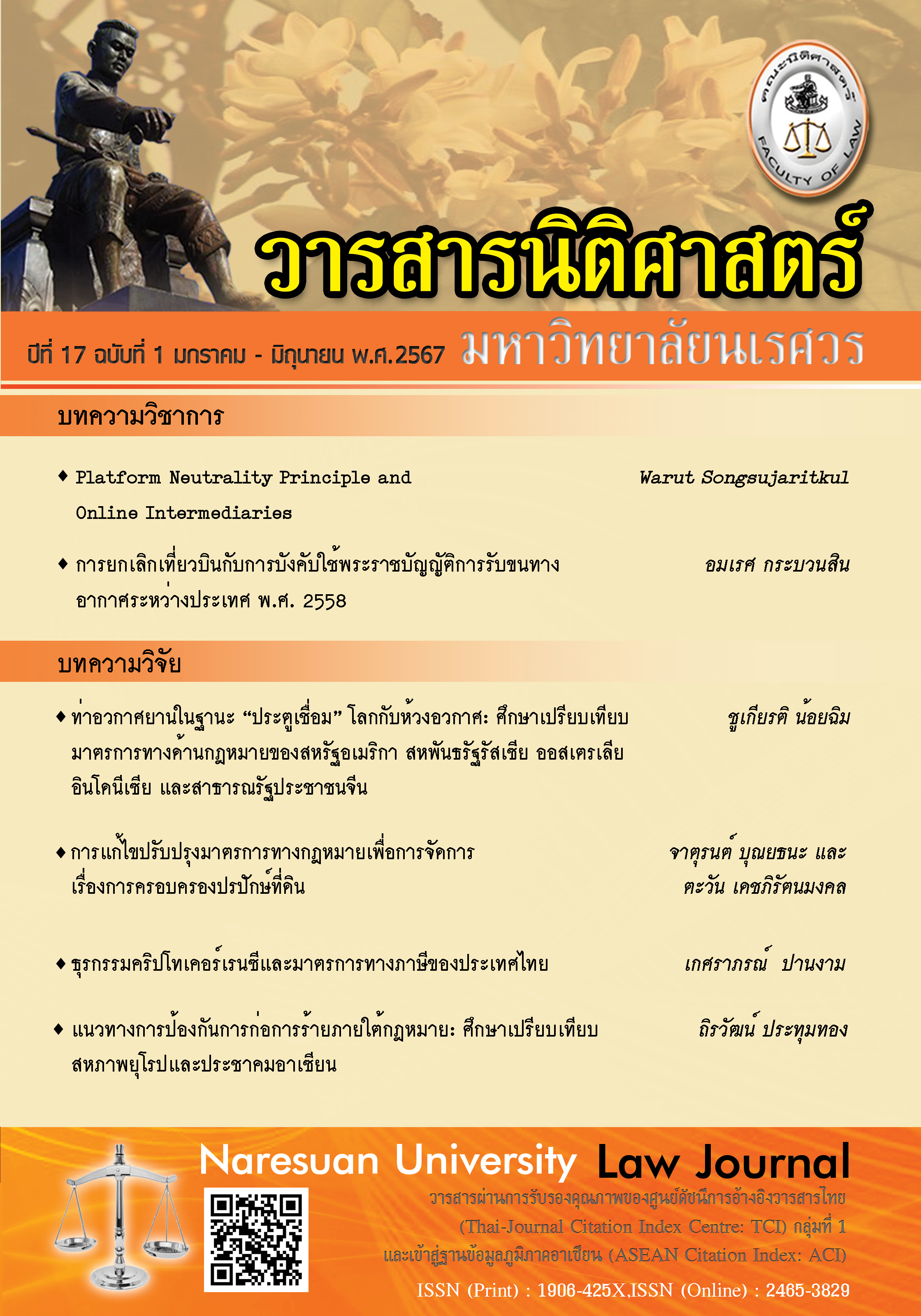The Spaceport as “Gateway” between the Earth and the Outer Space: A Comparative Study of Legal Measures of The United States of America, Russian Federation, Australia, Indonesia and People’s Republic of China
Main Article Content
Abstract
The objectives of this article are to study and compare guidelines and measures related to the establishment of spaceports in various foreign countries, including the United States, the Russian Federation, Australia, Indonesia, and the People’s Republic of China. The aim is to derive effective guidelines applicable to the establishment of a spaceport in Thailand. Currently, a ‘Spaceport’ is considered an essential infrastructure for space activities, serving as ‘the gateway to outer space.’ It marks the starting point for humanity’s exploration and utilization of outer space, promoting the New Space Economy and bridging gaps in space development. The research indicates that for each country there are: (1) its own ‘definition’ of spaceports, tailored to its specific context; (2) some common characteristics, particularly the specified purpose ‘for launching space objects (including astronauts) into outer space’; and (3) the establishment of operational guidelines for the spaceport. Regarding operational models, countries generally adopt one of three approaches: (3.1) the state acts as the sole operator of the spaceport, (3.2) the state allows the private sector to operate the spaceport, with the state serving as the sole promoter and regulator, and (3.2) joint operation by both the state and the private sector. For recommendations to Thailand on establishing a spaceport, Thailand shall (1) issue policies and laws for establishing a spaceport, (2) clearly define the definition of “spaceport”, (3) clearly specify the objectives for establishing a spaceport, and (4) determine the operating model for establishing a spaceport by using the model (4.1) granting licenses and/or permissions to the private sector under promotion and supervision by the state, or (4.2) a jointly governmental and private sector operation model.
Article Details
References
Australia Government, Department of Industry, Science and Resources. “National Civil Space Priority Areas.” Last modified April 1, 2019. Accessed September 21, 2023. https://www.industry.gov.au/publications/australian-civil-space-strategy-2019-2028.
Dachyar, Muhammad, and Purnomo Herry. “Spaceport Site Selection with Analytical Hierarchy Process Decision Making.” Indian Journal of Science and Technology 11, no. 10 (2018): 1-8.
Drescher, Juergen, Sven Kaltenhäuser, and Dirk-Roger Schmitt. “Nas Integration: Cst and Air Traffic Insertion the Way Ahead.” Paper presented at the Space Traffic Management Conference, 2018. https://commons.erau.edu/stm/2018/presentations/21
Federal Aviation Administration. “Office of Spaceports.” Last modified August 8, 2023, 2024. Accessed September 21, 2023. https://www.faa.gov/space/office_spaceports.
Frost & Sullivan. Uk Spaceport Business Case Evaluation (Research Report). N.p.: N.p., n.d.
Geo-Informatics and Space Technology Development Agency (Public Organization). “Thailand Joins with Korea to Study the Feasibility of Preparing to Build a “Spaceport” in Thailand.” Last modified February 13, 2023. Accessed January 7, 2024. https://www.gistda.or.th/news_view.php?n_id=6747&lang=TH. [In Thai]
Global Spaceport Alliance. National Spaceport Network Development Plan (Research Report). Washington, DC: Office of Spaceports, Office of Commercial Space Transportation, Federal Aviation Administration, 2020.
Learning English. “Us Company Tests System to ‘Spin Launch’ Satellites to Space.” Last modified October 9, 2022. Accessed September 21, 2023. https://learningenglish.voanews.com/a/us-company-tests-system-to-spin-launch-satellites-to-space/6780174.html.
MGR Online. “Big Tu” Supports Studies and Construction of Space Launch Bases in Thailand, Generating Income for the Entire Related Industry System, with More Than 400 Occupations.” Last modified August 6, 2023. Accessed January 7, 2024. https://mgronline.com/politics/detail/9660000070509. [In Thai]
Team Project Report, International Space University. Oasis Operations and Service Infrastructure for Space Team Project: Spaceports (Research Report). Strasbourg: International Space University Strasbourg Central Campus, 2012.
The working group considered the preliminary feasibility of establishing a spaceport in Thailand. Studying the Concept of Developing a Spaceport in Thailand (Research Report). N.p.: n.p., n.d. [In Thai]
United Nations Office for Outer Space Affairs. “Copuos History.” Accessed January 6, 2024. https://www.unoosa.org/oosa/en/ourwork/copuos/history.html.
United Nations Office for Outer Space Affairs. ““Sputnik-1” Launched into Earth Orbit.” Accessed January 6, 2024. https://www.unoosa.org/oosa/en/timeline/index.html.


